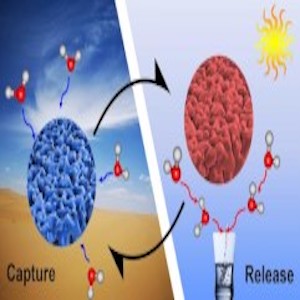Using AI to control energy for indoor agriculture
30 September 2024
Harnessing solar energy to take water from the air
Published online 11 February 2024
A simple new system to harvest water from the atmosphere could help Arab countries most affected by water stress

But these are also some of the sunniest places in the world. The abundance in sunshine makes them the perfect candidate to employ a new technology developed by researchers from Shanghai Jiao Tong University in China to harvest water from the atmospheric air using solar energy.
The authors of the study, published in Applied Physics Review, say that the technology can be used to provide daily water supply for drinking, as well as for industrial and domestic needs.
Previous attempts to harvest atmospheric water relied on injecting salt into hydrogels, thin, soft polymeric materials that increase in size in water. The higher content of salt reduced the swelling capacity of hydrogels and led to salt leakage and decreased water absorption capacity.
Authors of the new study synthesized an absorbent in the form of a super-hygroscopic gel and hygroscopic salts.
“This hydrogel is capable of absorbing an unparalleled amount of water and retaining it to obtain the highest return from harvesting water from the atmospheric air,” says Chengjie Xiang, a researcher at the Institute of Refrigeration and Cryogenics (IRC) at Shanghai Jiao Tong University, and the lead author of the study.
Xiang adds tells Nature Middle East that just one kilogram of dry gel can absorb 1.18 kilograms of water in arid weather environments and up to 6.4 kilograms in humid weather environments.
“We made a magic cookie with lots of holes designed to hold large amounts of water like a sponge. The water content is snatched from the atmospheric air by the adsorbent cookie,” Xiang explains.
With this technology, the researchers heat the ‘cookie’ to absorb the water content, which could then be condensed. The technology, Xiang explains, is easy to prepare in a domestic kitchen as the raw material is whipped into a foam then baked. The cherry on top, he adds, is that the cost of preparing it on a large scale does not exceed $15 per kilogram.
Harvesting water wealth for the Arab world
More than 80% of the Arab world is made up of deserts, which receive an annual rainfall that does not exceed 200 millimeters on average. This makes the Arab land one of the driest in the world.
But the desert may hold wealth. There is a significant amount of water content in the atmospheric air.
“The Arab region has a distinctive geographical location, vast deserts, and great potential for producing solar energy, especially with sunny weather most of the year. Many Arab countries such as Egypt and Morocco, Saudi Arabia, the UAE, and Jordan invest extensively in renewable energy in general, including solar energy projects,” says Jauad El Kharraz, executive director at the Regional Center for Renewable Energy and Energy Efficiency (RCREEE).
According to a report released by the Global Energy Observatory last September, the MENA region's top solar power producers are the UAE, Oman, Morocco, Egypt, and Jordan.
The total operating solar energy capacity in Egypt exceeded 2 gigawatts as of May 2023, with future plans to add 20.6 gigawatts, while the total operating capacity in Jordan exceeded 1.14 gigawatts, with plans to add 1.16 gigawatts.
This reliance on solar power and abundance in sunshine makes the Arab region among the most promising regions to implement Xiang's technology. The discrepancy in temperature between days and nights in the Arab world, and the relative humidity increase at night are all favorable conditions for the absorbing of moisture from the air. The daytime high temperatures also makes it easier to use solar energy for desorbing the absorbed humidity to obtain fresh water.
“This would enable millions of people who lack regular access to safe drinking water able to obtain simple devices that would help them collect water in their homes easily,” he adds.
doi:10.1038/nmiddleeast.2024.47
Stay connected: